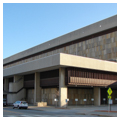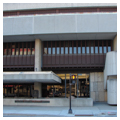When postal service automation arrived in the 1960s, the federal building could not accommodate the new machinery, and a 900-foot-long rectangular building was erected near the new train station. A band of Lannon stone cladding is sandwiched between two precast concrete layers, and a concrete parapet hides the mechanical systems. The rusty-looking Cor-Ten steel exterior accents were a Milwaukee first, and the curved exterior stairs offer a rakish entrance to the facility. A rail siding feeds into the building’s south side, and mail trucks use a spiral ramp entering the east side. In addition to its role as Milwaukee’s main post office, it is the largest processing and distribution center in Wisconsin, employing 3,600 people. Seven million pieces of mail pass via a conveyor through letter and package sorters daily.
You are here
Milwaukee Main Post Office (U.S. Post Office)
If SAH Archipedia has been useful to you, please consider supporting it.
SAH Archipedia tells the story of the United States through its buildings, landscapes, and cities. This freely available resource empowers the public with authoritative knowledge that deepens their understanding and appreciation of the built environment. But the Society of Architectural Historians, which created SAH Archipedia with University of Virginia Press, needs your support to maintain the high-caliber research, writing, photography, cartography, editing, design, and programming that make SAH Archipedia a trusted online resource available to all who value the history of place, heritage tourism, and learning.










